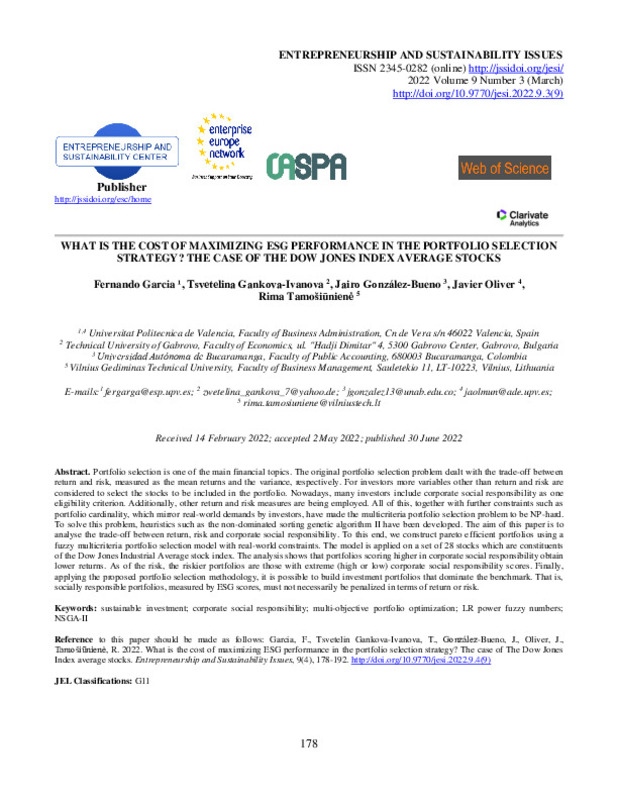JavaScript is disabled for your browser. Some features of this site may not work without it.
Buscar en RiuNet
Listar
Mi cuenta
Estadísticas
Ayuda RiuNet
Admin. UPV
What is the cost of maximizing ESG performance in the portfolio selection strategy? The case of The Dow Jones Index average stocks
Mostrar el registro sencillo del ítem
Ficheros en el ítem
| dc.contributor.author | García García, Fernando
|
es_ES |
| dc.contributor.author | Gankova-Ivanova, Tsvetelina
|
es_ES |
| dc.contributor.author | González-Bueno, Jairo
|
es_ES |
| dc.contributor.author | Oliver-Muncharaz, Javier
|
es_ES |
| dc.contributor.author | Tamosiuniene, Rima
|
es_ES |
| dc.date.accessioned | 2023-10-10T18:03:07Z | |
| dc.date.available | 2023-10-10T18:03:07Z | |
| dc.date.issued | 2022-03-30 | es_ES |
| dc.identifier.uri | http://hdl.handle.net/10251/197966 | |
| dc.description.abstract | [EN] Portfolio selection is one of the main financial topics. The original portfolio selection problem dealt with the trade-off between return and risk, measured as the mean returns and the variance, respectively. For investors more variables other than return and risk are considered to select the stocks to be included in the portfolio. Nowadays, many investors include corporate social responsibility as one eligibility criterion. Additionally, other return and risk measures are being employed. All of this, together with further constraints such as portfolio cardinality, which mirror real-world demands by investors, have made the multicriteria portfolio selection problem to be NP-hard. To solve this problem, heuristics such as the non-dominated sorting genetic algorithm II have been developed. The aim of this paper is to analyse the trade-off between return, risk and corporate social responsibility. To this end, we construct pareto efficient portfolios using a fuzzy multicriteria portfolio selection model with real-world constraints. The model is applied on a set of 28 stocks which are constituents of the Dow Jones Industrial Average stock index. The analysis shows that portfolios scoring higher in corporate social responsibility obtain lower returns. As of the risk, the riskier portfolios are those with extreme (high or low) corporate social responsibility scores. Finally, applying the proposed portfolio selection methodology, it is possible to build investment portfolios that dominate the benchmark. That is, socially responsible portfolios, measured by ESG scores, must not necessarily be penalized in terms of return or risk. | es_ES |
| dc.language | Inglés | es_ES |
| dc.publisher | Enterpreneurship and Sustainability Center | es_ES |
| dc.relation.ispartof | Enterpreneurship and Sustainability Issues | es_ES |
| dc.rights | Reconocimiento (by) | es_ES |
| dc.subject | Sustainable investment | es_ES |
| dc.subject | Corporate social responsibility | es_ES |
| dc.subject | Multi-objective portfolio optimization | es_ES |
| dc.subject | LR power fuzzy numbers | es_ES |
| dc.subject | NSGA-II | es_ES |
| dc.subject.classification | ECONOMIA FINANCIERA Y CONTABILIDAD | es_ES |
| dc.title | What is the cost of maximizing ESG performance in the portfolio selection strategy? The case of The Dow Jones Index average stocks | es_ES |
| dc.type | Artículo | es_ES |
| dc.identifier.doi | 10.9770/jesi.2022.9.3(9) | es_ES |
| dc.rights.accessRights | Abierto | es_ES |
| dc.contributor.affiliation | Universitat Politècnica de València. Facultad de Administración y Dirección de Empresas - Facultat d'Administració i Direcció d'Empreses | es_ES |
| dc.description.bibliographicCitation | García García, F.; Gankova-Ivanova, T.; González-Bueno, J.; Oliver-Muncharaz, J.; Tamosiuniene, R. (2022). What is the cost of maximizing ESG performance in the portfolio selection strategy? The case of The Dow Jones Index average stocks. Enterpreneurship and Sustainability Issues. 9(4):178-192. https://doi.org/10.9770/jesi.2022.9.3(9) | es_ES |
| dc.description.accrualMethod | S | es_ES |
| dc.relation.publisherversion | https://doi.org/10.9770/jesi.2022.9.3(9) | es_ES |
| dc.description.upvformatpinicio | 178 | es_ES |
| dc.description.upvformatpfin | 192 | es_ES |
| dc.type.version | info:eu-repo/semantics/publishedVersion | es_ES |
| dc.description.volume | 9 | es_ES |
| dc.description.issue | 4 | es_ES |
| dc.identifier.eissn | 2345-0282 | es_ES |
| dc.relation.pasarela | S\484128 | es_ES |








